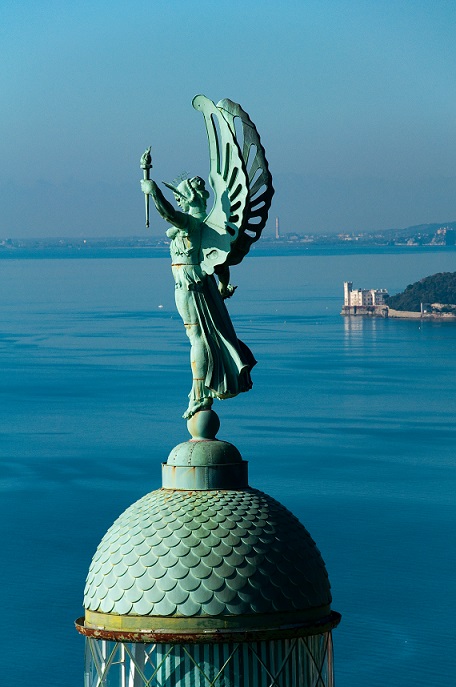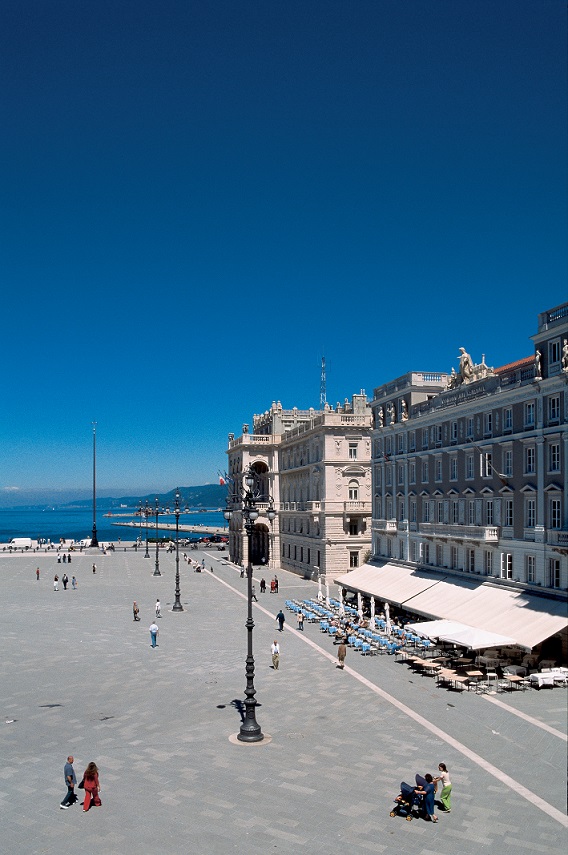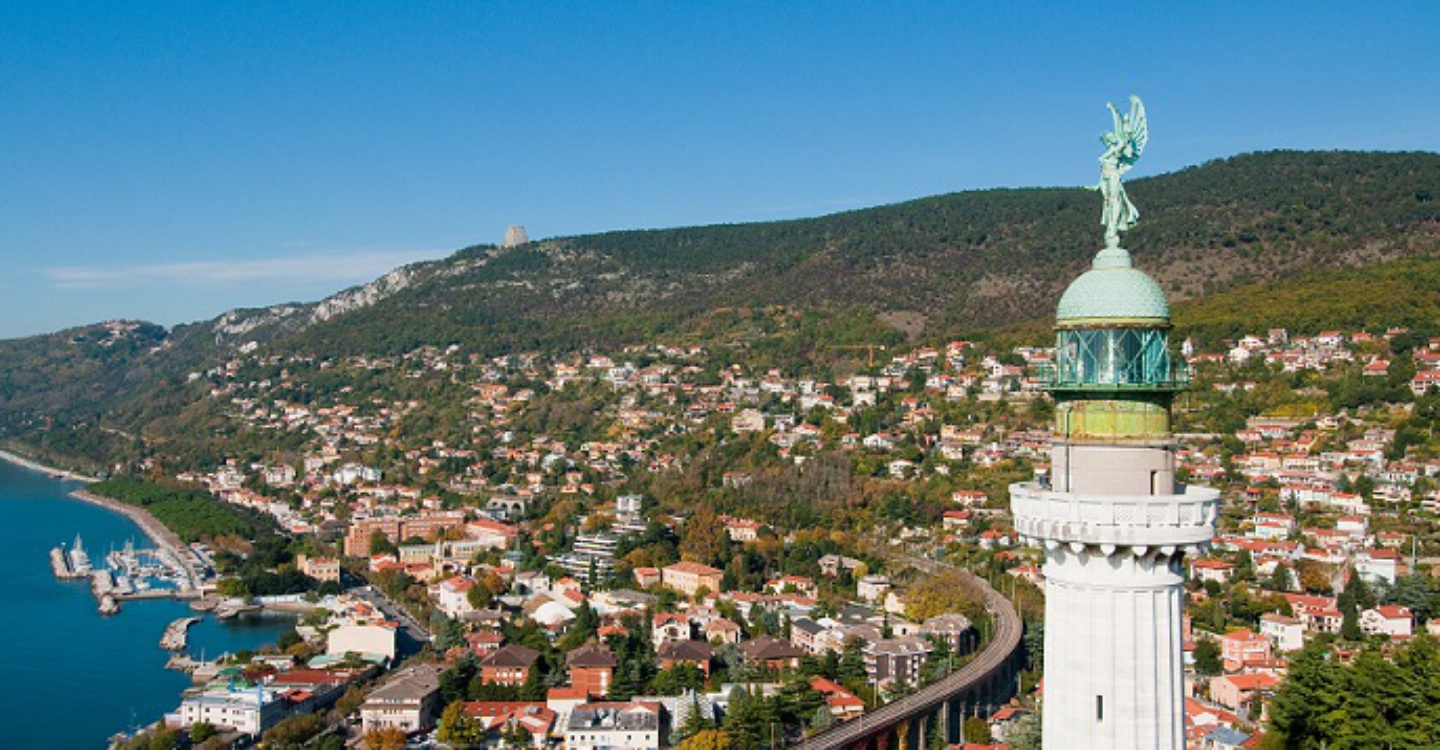One thing is certain, there is no single way to observe it, taste it and live it. The important thing is to do it from different perspectives and without losing the curiosity to grasp every detail because Trieste is indeed beautiful, different from the first glance than other Italian cities. From the secluded alleys it is enough to re-emerge in the trajectories of the great squares and monuments because the city regains its most well-known face, the multicultural and Central European face. But also multi-ethnic and plurilingual. When Trieste is talked about, the qualifying adjectives never seem too many: the city of wind and literary cafés, of the Barcolana and the Karst, the center of gravity of Friuli Venezia Giulia between the Prealps and “the Àdriatico Mar” - as D'Annunzio defined it -, was and is a crossroads of people and thinkers, religious and rulers, intellectuals and writers, such as to make it a unique place: in the homeland of Italo Svevo, numerous artists and authors are gravitated, between the eighth and twentieth century, by James Joyce - who began writing the Ulysses - to Giuseppe Verdi to whom the city's main opera house is dedicated. In Trieste, in the "little Vienna on the sea", there is the largest synagogue in Europe, dated 1912, and the only extermination camp on the peninsula - the Risiera di San Sabba - today an important civic museum. Surrounded by the Karst upland, on the hill of San Giusto the cathedral and fortress of the same name rise, while down the coast, the Miramare Castle, an icon of the Habsburg dynasty and home to a park and historical museum of rare composure, offers an unforgettable glimpse of the gulf. Palaces of neoclassical, liberty and baroque styles embrace the piazza par excellence, Unità d'Italia, the largest in the old continent among those facing the sea, and its Audace pier, a catwalk of over 200 meters “where I never feel alone ”, Recalling another illustrious Trieste, Umberto Saba. And if the shopping street is Corso Italia, Via Torino is the place to meet at aperitif time, for a white Spritz made with wine and seltzer with ice and lemon and a "rebechin", the meatball appetizer and breaded vegetables or a marinated sardine with vinegar and onion.



We suggest 20 ideas for an alternative visit, which you can also enjoy riding your bike.
1.Drink a "capo" at the Cavana.
Together with the San Giusto district and the old Jewish ghetto, the Cavana describes the boundaries of the 'Zità Vecia' - the old town in Trieste -, between narrow alleys and airy openings such as the square of the same name, dotted with new businesses and historic cafés: Coffee lovers should not miss a stop at 'La Triestina', for a loose blend from the roasting plant accompanied by a chocolate, remembering the legend: 'nero' is said for an espresso in a cup and 'nero in b' for a coffee in a glass, while 'capo' is the classic macchiato.
2.Delight yourself with an Austro-Hungarian pastry.
It looks like a turn-of-the-century jewellery shop, but it is an Art Nouveau pastry shop: the Bomboniera in Via Trenta Ottobre, 3, with its frosted glass and chequered floor, is the perfect place to taste typical Austro-Hungarian sweets, baked in the original wood-fired oven dating back to 1836: there is the Pinza, a sweet bread typical of the Easter tradition, the Putizza, a leavened pastry filled with walnuts, sultanas, chocolate and rum, and also the presnitz, a puff pastry filled with dried fruit and the classic Trieste broad beans.
3.Trieste, 'La Porta Rossa' and Commissioner Cagliostro.
Those who love the fiction set in Trieste, 'La Porta Rossa', should not miss a visit to the streets frequented by the Commissioner Cagliostro. You can visit the filming locations on your own. Palazzo Carciotti, in Riva 3 novembre, at the beginning of the Canal Grande, the Ursus, a pontoon-crane from the 1930s, a rare find of industrial archaeology in the Gulf of Trieste; in the third season, this location has been replaced with the Faro della Vittoria (Lighthouse). In addition to the lighthouse, the commissioner also likes to observe Trieste from the top of the Torre dell'Orologio (clock tower), located on the famous Piazza Unità d'Italia. Those who follow the series will recognise other places; such as the historic Palazzo Vivante, home of the Trieste upper middle class, the Opicina power station on the Carso upland, the Ausonia bathing establishment and the Sgonico Quarry.
4.Shopping at the grocer's.
In Piazza San Giovanni, opposite the statue of Giuseppe Verdi, there is a historic shop, open since 1906 and much loved even by tourists: it is the Drogheria Vittorio Toso, where you can buy all kinds of products, from bath salts to natural sponges, not to mention soaps and pure horsehair brooms, back-scratchers and dust-catchers. The wooden shelves soar to the ceiling and from the glass jars flash spices and coloured mints, honey balsamics and sugar devils, like in a turn-of-the-century novel.
5.Browse through rare books and antiques.
Ancient or modern texts from more or less rare editions, vintage postcards and prints from the mid-19th century or 33 rpm, but also furniture and knick-knacks, paintings and newspapers and all kinds of curiosities: at Laura and Claudio di Pinto's Rigatteria (open on Sundays the third week of every month) you can really find everything, in an exquisitely quiet and cosy atmosphere, in the historic heart of Trieste. Info www.rigatteria.com.
6.Find a vintage ornament.
Precious pocket-emptyers, porcelain boxes, wooden angels, doorstop turtles. And even globes, wall sconces, clothes hangers, magazine racks: there is a whole world of rarities and trinkets, valuable ornaments and opalescent knick-knacks at Michele Tagliente's Trieste Modernariato e Antiquariato shop, a must for vintage enthusiasts, just a few steps from the very central Via Malcanton and Piazza Unità d'Italia.
7.Have a 'rebechin' at Pepi's.
In the rooms of this rustic and friendly local in the centre, inaugurated in 1897 and mentioned by national and international guides and networks - even CNN mentioned it -, personalities such as the Count of Spoleto or Prince Tripcovich, Torquato Tasso and Baron Bonomo have passed through. A stop is a must for a 'rebechin', the mid-morning snack of 'uganighe e capuzi' (sausage and sauerkraut). Buffet da Pepi, Via Cassa di Risparmio, 3, Sunday closed.
8.Buy a book at the historic Caffè San Marco.
Opened in 1914, when Trieste was still the third centre of the Austro-Hungarian Empire after Vienna and Prague, it was a cultural salon, a gathering of irredentists, a literary circle for writers such as Italo Svevo, Umberto Saba and James Joyce. A 'heart of the city', as Magris defines it, honoured with the title of 'historical café of Italy', the San Marco café is perhaps the most famous and representative tea room in Trieste, a quiet and elegant place - also a restaurant and bookshop - where one can meet for book presentations and tango courses. Antico Caffè San Marco, Via Cesare Battisti, 18.
9.Take a walk through the squares.
There are at least three main squares in Friuli's capital: Piazza Unità d'Italia, dominated by the Town Hall at the foot of the San Giusto hill; Piazza Giuseppe Verdi, home to the theatre of the same name and a sumptuous venue for events and concerts; and Piazza della Borsa, with its more intimate and relaxed atmosphere. But strolling through the streets of the centre, a visit to Piazza del Ponterosso is also a must. Its name recalls the colour of the iron bridge, originally wooden and openable, on which stands a statue of the Irish writer James Joyce.
10.Enjoy the sunset on the Audace pier.
Looming over the gulf of Trieste, halfway between the San Giorgio and San Giusto basins of the Porto Vecchio, and just a few steps from the magnificent Piazza Unità d'Italia, stands a 246-metre-long walkway: the Audace pier, named after the first ship destroyer to enter the port, at the top of which stands a bronze wind rose, and which provides a privileged viewpoint over the city at sunset.
11.Visit the castle and cathedral of San Giusto.
On a hill overlooking the old town stands a fortress, the San Giusto Castle, commissioned by the emperors of Austria and housing two important sections of the Civic Museums of History and Art. From its patrol walkways you can enjoy an exceptional view of the old town and the port area, while in the nearby cathedral of the same name - the most important Catholic religious building in Trieste - you can admire, in addition to the Gothic rose window in Karst stone on the façade, the magnificent mosaics of the apses, the work of Venetian and Constantinopolitan craftsmen.
12.Discover the ecclesiastical morphology.
There is an Evangelical-Lutheran church, a Greek Orthodox church and an Israelite temple, as well as several civil cemeteries, such as the Anglican and the Mohammedan, referring to non-Catholic cults, reminding us that Trieste is the multiethnic city par excellence. Among the Christian churches, St. Antonio's church stands out, close to the Canal Grande, whose facade is embellished by six Ionic columns and statues of saints, while the synagogue, second in size only to the Budapest Temple, is considered the largest and most important European building of Jewish worship.
13. Admire masterpieces of modern art.
At Via Diaz, 27, a short walk from the banks, you will find the Revoltella Museum, a modern art gallery, built between 1854 and 1858 and belonging, in the form of a private residence, to the Baron Pasquale Revoltella, one of the most influential figures of imperial Trieste, where you can admire 350 works of painting and sculpture in around 4000 square metres of exhibition space. Art workshops for children, music mornings and film screenings in the Civic Museum Auditorium complete the cultural offer.
14.The Synagogue, Trieste's Jewish Temple.
The Synagogue, rebuilt at the end of the Second World War, is the most tangible sign of the centrality of the Jewish community in the city's history. In 1938 Trieste had over 6,000 residents of Jewish origin. When, five years later in 1943, the German occupation began, the city paid a high tribute both in terms of lives broken - the Risiera di San Sabba was turned into a prison camp - and in terms of the riches and works of art stolen, many of which were kept in the very Synagogue promptly occupied by the Reich military.
15. Stepping back in history.
The only Nazi lager in southern Europe. It was with this motivation that the President of the Republic Giuseppe Saragat declared the Risiera di San Sabba a National Monument in 1965. After 1943, the Germans transported to this area used for husking rice, thousands of partisans, Slovenes, Croats, Jews and political opponents who had been captured during the round-ups. Many of these - the most reliable estimate is 5,000 - were killed on the spot, while others, including women and children, were transferred to the Auschwitz and Dachau concentration camps. Today it is a national monument and the site of a commemorative museum with a photographic-documentary itinerary illustrating its history, framing the political context, and a collection of personal items looted from the Jews of Trieste, to reconstruct the lives of the persecuted. Museo della Risiera di San Sabba, via Giovanni Palatucci, 5 - Opening hours: summer (1/4-30/9) daily 9am-7pm - winter (1/10-31/3) daily 9am-5pm - free admission. www.risierasansabba.it.
16.Visit the Castle of Miramare.
On the top of the rocky promontory of Grignano, about ten minutes from the historic centre of Trieste, there is a masterpiece of eclectic architecture and Habsburg opulence surrounded by 22 hectares of parkland: this is Miramare Castle. The residence of Archduke Ferdinand Maximilian, this mid-19th-century aristocratic residence, in whose rooms Sissi, Empress Elisabeth of Austria, also stayed, is today home to a virtuoso historical museum with guided or themed tours and interesting temporary exhibitions, cultural events and conference cycles. In addition, the stretch of water surrounding the castle was turned into a marine reserve in the 1990s: a protected area where it is possible to practice various underwater activities from diving to snorkelling.
17.Venturing into a Guinness cave.
On the Karst upland, just a few kilometres from the centre of Trieste, there is a Guinness world record cave, first explored in 1840 and opened to the public at the beginning of the last century, with the world's largest natural hall: the Grotta Gigante. Visitable all year round, this millenary place, monumental since its name, is home to numerous educational activities and tourist routes. Inside, it is possible to spot fossils that became extinct 65 million years ago and stalagmites of astounding dimensions, such as the 12-metre-high 'Roger Column'. The only recommendation is to wear suitable clothing for the excursion: from shoes to a sweatshirt considering the depth and temperature range. Info www.grottagigante.it.
18.That tram to Opicina.
That Trieste is a unique city you also realise by taking the tram. In fact, the Opicina tram is not just a means of public transport, but an atmospheric and scenic excursion outside the city. With its old blue carriages, more than a means of transport, it is a tourist attraction that connects the central Piazza Oberdan with the karstic village of Opicina, after more than 5 kilometres of route and 329 metres of elevation gain. It is a journey worth taking and then enjoying the panorama of the town once you arrive at the Obelisk belvedere. Info: www.tramdeopicina.it. The line 2 service (Opicina tram) is temporarily suspended.
19.Visit the Faro della Vittoria lighthouse.
It dominates and illuminates the entrance of the harbour. The lighthouse, more than 60 metres high and considered the most powerful in the Adriatic, is also a monument to the fallen of the First World War. The inscription at the base of the structure 'Shine and remember the fallen at sea' immediately tells us what the intentions of Trieste architect Arduino Berlam were when he designed the work in the aftermath of the defeat at Caporetto and the Piave River. Built between 1923 and 1924, its dome is topped by a copper statue of Winged Victory, another work by Triestine sculptor Giovanni Mayer, created by copper and iron craftsman Giacomo Sebroth.
20.Duino Castle and the Rilke path.
Situated in a strategic position, dominating and controlling the gulf of Trieste, today's Duino Castle is what remains of a fortified complex that originally consisted of two manors: the lower and the upper, or 'new' castle, which we can still admire today. The beautiful park surrounding it was created in the 19th century with a multi-storey Mediterranean-style garden. This place saw illustrious guests, perhaps Dante, certainly Rainer Maria Rilke, who composed the Elegie Duinesi here. And it is from the poet that the picturesque path that winds between the Duino promontory and the Sistiana bay takes its name. At a length of 1.7 km and at a height of about 80 metres above sea level, it offers beautiful views from panoramic belvederes that were used as firing positions during World War II.
